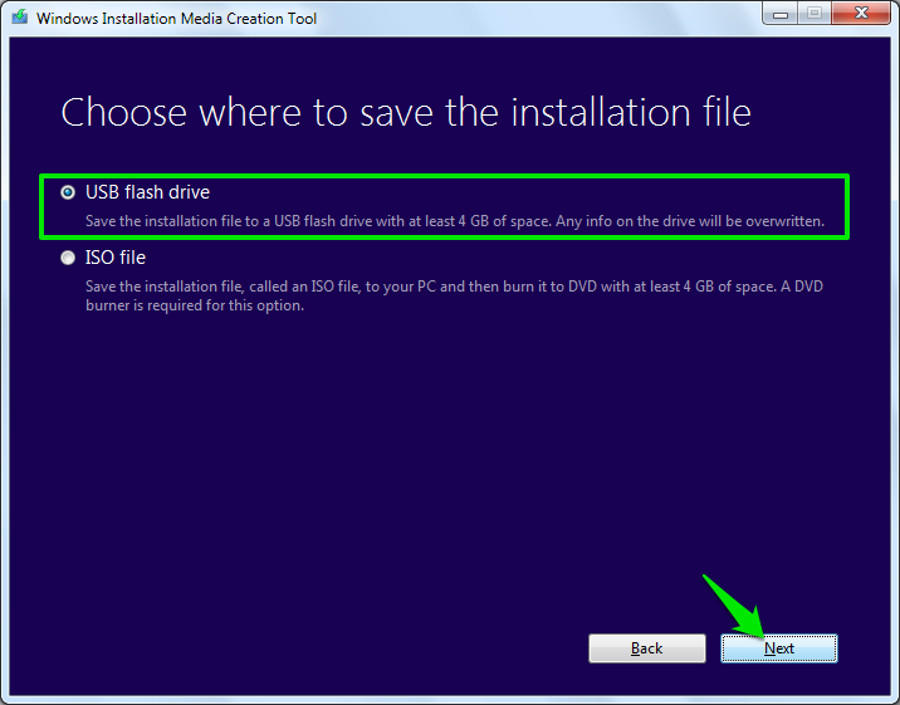

- #Windows 10 usb tool 4gb how to#
- #Windows 10 usb tool 4gb install#
- #Windows 10 usb tool 4gb update#
- #Windows 10 usb tool 4gb windows 10#
- #Windows 10 usb tool 4gb software#
#Windows 10 usb tool 4gb how to#
How do you fit 4.1 GB on a 4 GB iso - that is the question not how to put it on usb.
#Windows 10 usb tool 4gb windows 10#
You will receive a warning message when trying to import Windows 10 ISO into the program and it recommends other tools instead for burning Windows ISO. Just format your USB stick as fat32, set the primary partition as active, then simply extract the entire ISO onto the stick. It will ask to choose a partitioning scheme. Format USB before creating Windows 10 Bootable USB. In the Disks tool, make sure to select your USB drive and hit format. You have to use this tool to format the USB key.

P.s Balena Etcher does not support Windows OS. In Ubuntu, press Super key (Windows key) and search for ‘Disks’. You can still use this app for creating bootable Windows USB on Catalina and Mojave as far as I know. However, this feature is removed from Boot Camp app on macOS Big Sur. It is a built-in free app shipped with macOS by default. If you are using an old version of Windows 10 ISO, then Boot Camp Assistant can help you get this done easily. Also, this app works on latest Big Sur and M1 Mac as just tested it on a M1 MacBook Air with macOS Big Sur 11.5. It automatically splits the large ISO file into small parts so the Windows installation files can be sit on a FAT32 partition, which is the only working file system supported by Mac for Windows install. If you are using a newer Windows 10 ISO (after version 201809), then UUByte ISO Editor is the best app for creating a bootable USB on Mac. I managed to create several bootable Windows 10 USBs on Mac (Mojave, Catalina and Big Sur) in recent years.
#Windows 10 usb tool 4gb software#
The highlight of this software is that it can automatically process ISO files larger than 4GB. I also tried other alternative tools like SYSGeeker WonderISO, UNetbootin and UUByte ISO Editor, they're really great softwares and each has its own merit. PS: This method is a bit difficult and error-prone and is not recommended if you are a novice. Wimlib-imagex split /Volumes/CCCOMA_X64FRE_EN-US_DV9/sources/install.wim /Volumes/WIN10/sources/install.swm 4000 Finally enter the command this command to end the process:
#Windows 10 usb tool 4gb install#
Rsync -avh -progress -exclude=sources/install.wim /Volumes/CCCOMA_X64FRE_EN-US_DV9/ /Volumes/WINDOWS10ĭon't forgot to install the Homebrew. Copy all files except install.wim to the USB drive by using the following command prompt. If it's more than 4 GB, you'll need to split the file. So, I've tried Terminal to create a bootable USB on macOS. The problem is that on MacOS that format restricts individual files from being larger than 4gb, and the install.wim file in the Windows 10 iso must be more than 4 G.Įtcher doens't seem to be able to process the ISO file larger than 4 GB. And can quickly complete tasks without any technical requirements. UUbyte iSO Editor is a good choice for computer novices. The whole process won't take a long time. Just download and install this software on your Mac and run it. Suppose you are not interested in the above software. Generally speaking, the task is OK completed in 15 minutes.

iso file in UNetbottin and burn it to the USB flash drive. If you have installed Windows iSO files on your Mac, try UNetbottin, plug in the USB on Mac, and launch the Disk Utility option. But if you are a computer novice or are not know much about CMD, please find another way. If you are good at CMD, it is possible to use CMD to create Windows 10 bootable USB on a Mac in a virtual machine.
#Windows 10 usb tool 4gb update#
UPDATE on April 2nd, 2019: Rufus now supports downloading Windows 10 ISO from Microsoft. Bootable UEFI USB of Windows 10 using Rufus. 1.How about the boot camp Assistant? Although it does not work sometimes, as a multi-boot creation utility, it can create a Windows 10 bootable USB on your Mac. And we will use the free Rufus tool to prepare bootable UEFI Windows 10 USB drive (method 1). If you can’t change the settings, place a checkmark next to the Use the recommended options for this PC option and proceed. Set your preferred Language, Windows 10 Edition, and System Architecture. You do need a valid Windows license to activate and use most versions of Windows, but you don’t need one to create an installable USB of Windows or perform the install. Select Create installation media (USB flash drive, DVD, or ISO file) for another PC and click the Next button. If you don’t currently have one you should go there to grab one. Remember: you can download Windows 10 disc images from the Microsoft website. are supported, and the tool works with both ‘legacy’ and ‘UEFI’ bootmodes, too.įor advanced use cases I recommend using the WoeUSB CLI as it has all sorts of flags and switches to curate custom installs with specialist needs.īut for everyone else the WoeUSB GUI client is all that’s needed.īefore we begin make sure you have all of the following to handy, as all are required to create a bootable Windows 10 USB on Ubuntu: Well, WoeUSB lets you make a bootable USB for various Windows releases, including Windows Vista, Windows 7, Window 8, and Windows 10.Īll languages and all variants of Windows, including Pro, Home, N, 32-bit, and more.


 0 kommentar(er)
0 kommentar(er)
